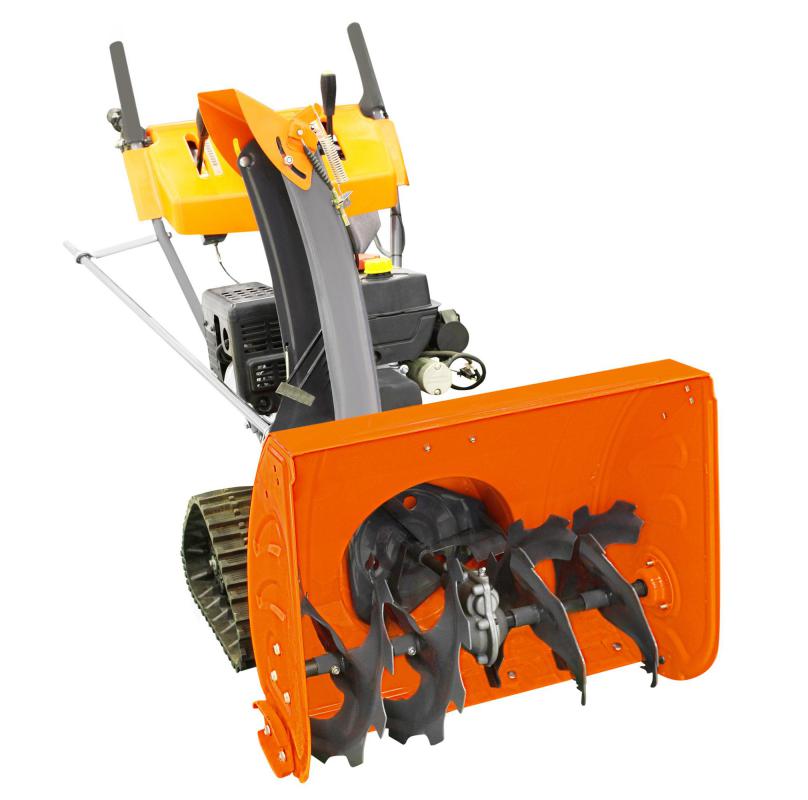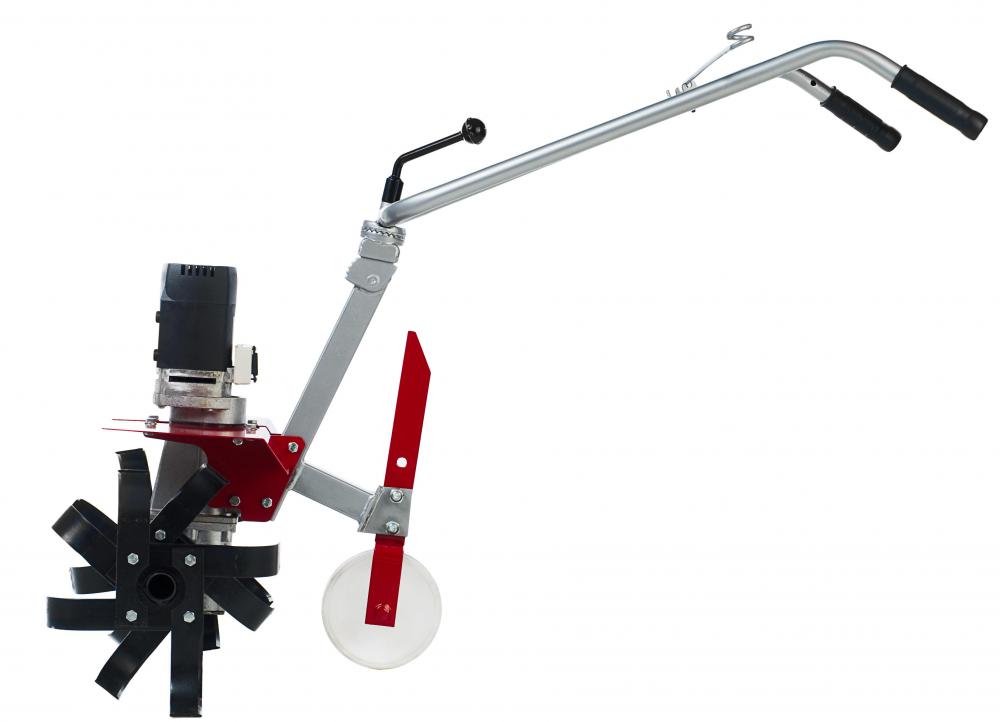At HomeQuestionsAnswered, we're committed to delivering accurate, trustworthy information. Our expert-authored content is rigorously fact-checked and sourced from credible authorities. Discover how we uphold the highest standards in providing you with reliable knowledge.
What is a Power Tiller?
A power tiller, also sometimes known as a rotary tiller, a rotoriller, a rotavator, or a rotary hoe or plow, is a garden tool used primarily to cultivate and aerate soil. There are a couple of different variations and available options, but the most characteristic aspect of this tool is its basic form and function: it has tines or blades that rotate to turn the soil, and in “power” options this rotation is harnessed to a motor. The tools are basically a mechanical adaptation of manual tillers, which are hand powered tools used for a similar purpose. Attaching the bladed mechanism to a motor makes it more efficient and less straining. Some of the least expensive models still require pushing and maneuvering, and are often compared to lawn mowers when it comes to their size and basic utility. Larger options can frequently be harnessed to farm machinery like tractors and ploughs. In some countries, a this sort of mechanized tiller may also be a two-wheeled tractor, which may have other attachments and functions aside from cultivation.
Basic Purpose

Agriculture and farming is about more than just simply planting crops. In many if not most cases, the soil also has to be tended to. Farmers have to pay attention to things like soil moisture, nutrient levels, and drainage in order for their plants to grow. Turning the soil and mixing it up a bit before planting is something most farmers and growers do to help the roots take hold and to loosen debris like rocks or other things that could impede proper root growth or nutrient absorption.

Tillers, whether manual or powered, are an important part of this process. These tools can prepare the ground for new plantings, which can help them grow stronger and become more resilient, two qualities essential for optimal growth. Professional farmers and growers are usually the most common consumers of these devices, but they also have useful applications for home gardeners. They tend to take up a lot of space, though, and as a result they’re usually only popular with people who have some place like a storage shed to house the machine when it’s not in use.
Brief History

The power tiller was invented in the early twentieth century to replace manual ploughing. Ploughing still happens in many parts of the world, particularly on small farms or gardens, but these more rudimentary tools typically take a lot of effort and energy to run. Manual models resemble their motorized counterparts, but get their energy entirely from a person pushing and manipulating it. This can become tiresome and straining when there are large areas to cover, and the process can also take a lot of time.

Motorized tillers generally have small, one- to five-horsepower engines that take gasoline or a mixture of gasoline and oil. They are designed to propel forward slowly and to allow for the user to control the friction by raising and lowering the handlebars. As a safety feature, most can propel only forward and not backward.
Main Uses Today
The main goal of these tools is usually to lessen the tough physical labor involved in turning, aerating, and cultivating soil. They have many uses besides simply turning soil, however, such as weeding, trench formation, top soil and fertilizer application, and garden or flower bed formation. Most manufacturers and retailers offer a number of different options, some of which are better suited for specific applications than others. Most are small in size and lightweight for easy handling; they typically have a low center of gravity, adjustable speed, low fuel consumption, and adjustable handlebars. Larger varieties are sometimes also available. Those with big crops or major estates to plough may find that a tiller that can attach to a riding mower or tractor is a more attractive option.
Pricing Information
Pricing for motorized tillers varies widely, depending on the size, horsepower, brand name, and quality. Most home improvement stores allow customers to rent tillers for one-time usage. Pricing may also depend on whether the machine is a front-tine or rear-tine tiller, the rear-tine variety often being the more expensive choice. People who regularly maintain a large garden may find that simply purchasing a device is more economical than renting one several times a year, though storage and maintenance are important considerations in these cases.
Maintenance and Safety Considerations
As a matter of safety, it’s usually a good idea for people to clear the area to be tilled of rocks, sticks, and other debris before getting started. Users should also generally wear long pants, safety glasses, and ear protection when operating the machine. It’s important for users to wait until the tiller has cooled down before refueling as well to prevent burns, fumes, and potential explosions.
Just like any other motorized lawn equipment, power tillers do require a certain amount of maintenance. With a bit of care, a power tiller can last for decades or more but abuse can cause damage and malfunction, both of which can be dangerous. Users should be sure to do things like emptying the fuel and thoroughly cleaning the device before storing it for long periods of time, for instance, and should take care to remove debris and farm waste at the end of each run.
AS FEATURED ON:
AS FEATURED ON:














Discussion Comments
Wonderful article about power tillers. Thanks to the author for explaining the facts so lucidly. Can you inform me about availability of power tillers with the cost of tillers and implements and amount of subsidy, etc.?
@highlighter- I bought one and hated it. It was underpowered for what I needed it for. I am being somewhat unfair though because the capabilities of this power tiller match the price. If you are doing anything more than small chores, the tiller is weak. It gets tangled in long roots and any rocks larger than a golf ball get caught in the tines.
You would probably like it for flowerbeds and such because it is lightweight and compact. Sometimes it can be a little hard to start, but for extra money, they will throw in an easy start kit. You will also need to service the machine regularly to keep it in top running condition. This is just my assessment of this tiller, and from what I could tell, the machines from different brands had few differences.
@amphibious54- I should look into getting one of those mini power tillers for our home. My wife and I are constantly planting and replanting our flowerbeds, and honestly, I hate doing all the work by hand. I have seen them at the garden store, but I have never used one. Has anyone else used them? What do you think of these tillers? Are they worth the money?
I bought one of those small tillers that I saw on the television and I was pleasantly surprised with its performance. I only have a small garden patch that I made in a corner of my lawn and the tiller works great. My garden is only 15 feet by 20 feet, but I grow enough vegetables to eat something fresh from my garden at least half the year.
That little tiller makes gardening so easy. Before I got the tiller, I would spend half a day turning over the soil and hours every summer edging and aerating my lawn and garden. The little tiller has a few nice attachments that let me aerate the lawn, till flower beds, and remove the weeds between my paver tiles without herbicides. They are versatile little garden tools.
Post your comments